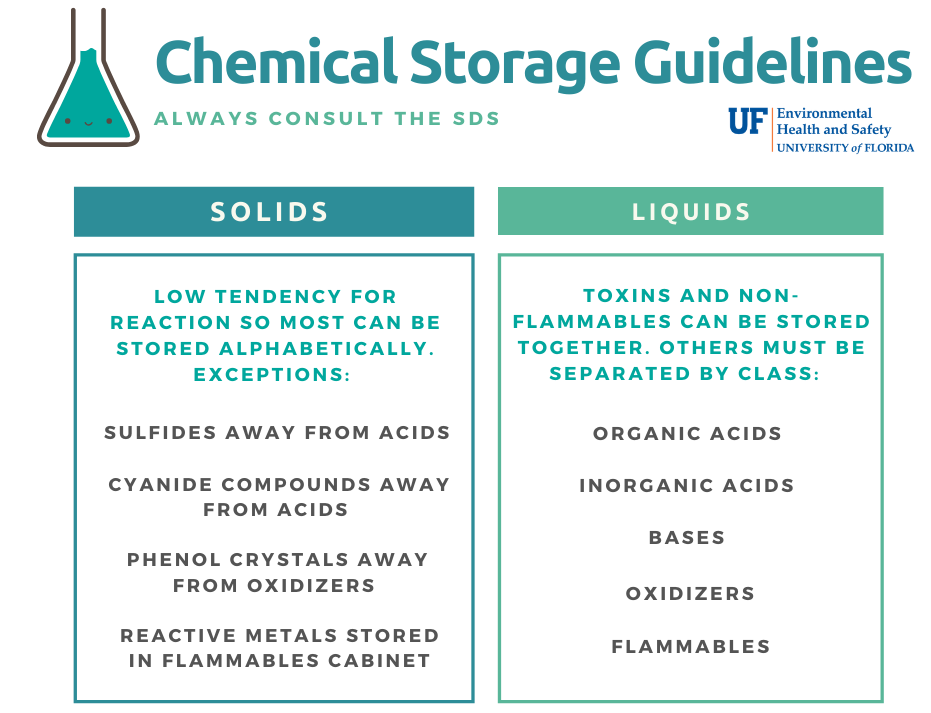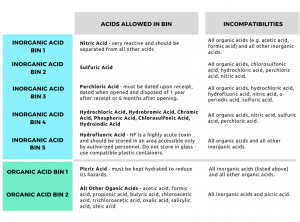
Chemical Safety, Storage and Management
The following is a general guideline on how chemicals should be stored in a laboratory setting. Always consult the Safety Data Sheet to identify incompatible materials and determine proper storage requirements.

General Rules for Chemical Storage
- Do not store liquid chemicals above shoulder height.
- Maximum quantity of flammables allowed outside of a flammable storage cabinet is 10 gallons.
- Only two 1-lb propane cylinders can be stored in the lab, with an additional two in a flammable storage cabinet.
- Bottles containing liquids may not be stored on the floor unless they are contained in secondary containment.
- Excessive chemical storage in hoods is not acceptable.
- Chemical waste shall be placed at the designated accumulation area, in appropriate receptacles, properly labeled and segregated by hazard class.
Solid or Powdered Chemicals
Most solid chemicals may be shelved alphabetically with the following exceptions:
- Phenol crystals must be separated from oxidizers.
- Cyanide compounds must not be stored near acids.
- Flammable solids should be stored segregated from other solids or in Flammable Storage Cabinets.
- Powdered metals should be stored as directed on the bottle label or SDS.
- Storage of some metals may depend on the conditions in which they are packed (e.g., in a flammable solvent), which may require storage in flammable storage cabinets.
Liquid Chemicals
All liquid chemicals must be segregated by hazard classification and stored only with compatible substances. The following categories of liquid chemicals should be segregated from other categories.
- Acids: Organic acids should be kept separate from inorganic (mineral) acids. Not all inorganic acids are compatible, please refer to the acid compatibility guide pictured on this page.
- Bases: May react violently with acids, oxidizers or flammables.
- Oxidizers: Keep away from acids, bases, organics and metals; keep cool. Examples of strong oxidizers: Perchloric acid, nitric acid, concentrated hydrogen peroxide.
- Flammable liquids: Minimize the amount of solvents on the benchtop or open shelving. A maximum of 10 gallons may be left out in the lab.
- Flammables, acids, bases, and oxidizers must all be kept separated from each other due to their incompatibility towards each other.
- Toxic liquids: Must be segregated and stored separately, as they could be released and/or intensified when reacting with the other chemicals.
Specific Hazards
Corrosives consist of four major classes: acids, bases, dehydrating agents and oxidizing agents. Inhalation of the vapors of these substances can cause severe respiratory tract irritation. Contact with these chemicals may cause burns to the skin, respiratory tract and eyes.
- Store separately in a cool ventilated area, away from metals, flammables and oxidizing material.
- Secondary containment, such as chemical resistant tubs or bottle carriers, should be used to isolate and protect bottles, especially when being transported.
- The storage area should be checked regularly for spills and leaks.
- Suitable spill clean-up materials must be available.
- Always pour acids into water, never the reverse. Remember: “AAA – Always Add Acids”
- Cap bottles securely. The only exception to this will be the loose capping of mixtures if they generate gases during storage. Examples would be Aqua Regia, piranha solutions and similar highly corrosive mixtures. These should be stored in fume hoods or vented cabinets.

- Storage of flammable materials should comply with those requirements specified in the NFPA 45 and EH&S regulations and guidelines.
- Household refrigerators and freezers are not equipped with electrical-safe controls and shall not be used to store flammable liquids. Only flammable rated refrigerators/freezers, as labeled by the manufacturer, may be used to store flammable liquids.
- When actively working with flammables, keep only small quantities (500 ml or less) of flammable materials available for immediate use.
- Quantities greater than ten (10) gallons stored cumulatively throughout a laboratory will require the use of a flammable storage cabinet.
- Fifty-five (55) gallon drums are not allowed in labs without EH&S approval.
Included in this class of chemicals are nitrates, permanganates and oxides. These compounds present fire and explosion hazards that can occur in contact with organic compounds and other oxidizing substances. Suggestions for safe use and storage:
- Oxidizing agents should be stored separately from flammable liquids, corrosives, organics, dehydrating agents and reducing agents.
- Strong oxidizing agents should be stored and used in glass or other inert containers. Corks and rubber stoppers should not be used.
- Oxidizing agents should be used with caution in the vicinity of flammable materials.
A cryogenic liquid is defined as a liquid with a normal boiling point below -240°F (-150°C, 123°K). There are a number of general precautions and safe practices that must be observed.
Hazards
- Extreme cold: can cause instant frost bite to exposed skin or eyes.
- Asphyxiation: can displace oxygen and create an asphyxiation hazard.
- Expansion: cryogens can expand up to 700x when evaporating. Rapid changes in temperature can result in tank or vessel explosions.
Minimum PPE
The required PPE for handling cryogens include:
- Standard lab attire, which includes full coverage shoes & long pants.
- Lab coat or equivalent (arms must be covered)
- Safety glasses and face shield
- Cryogen rated gloves (these are not the same as heat gloves).
Training
EH&S offers a recommended Liquid Nitrogen Training found on MyTraining under the course code UF_EHS866.
Compressed gas cylinders are found in many of the laboratories and shops throughout the University. Those individuals working with compressed gas cylinders should have a copy of the UF Safety Rules for Storage and Use of Compressed Gas Cylinders linked below. Labs must post this handout where gas cylinders are stored.
